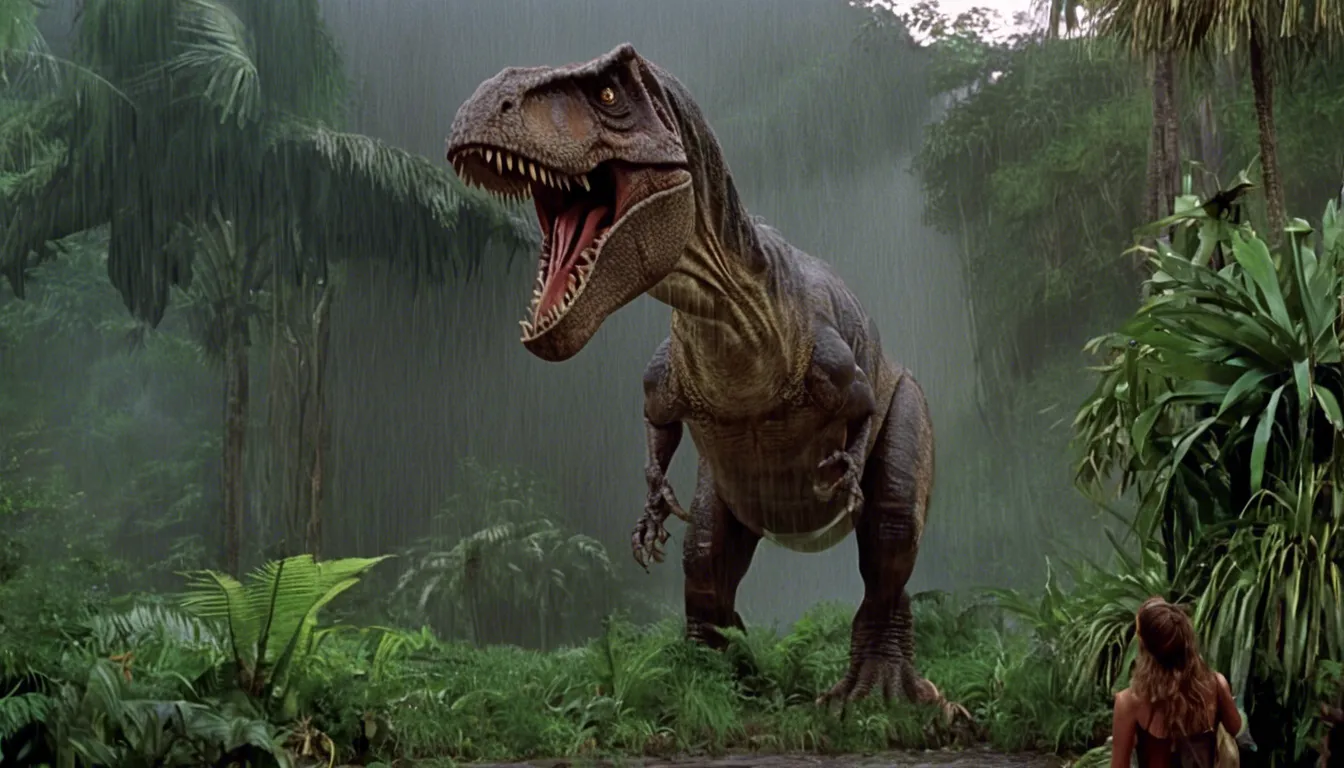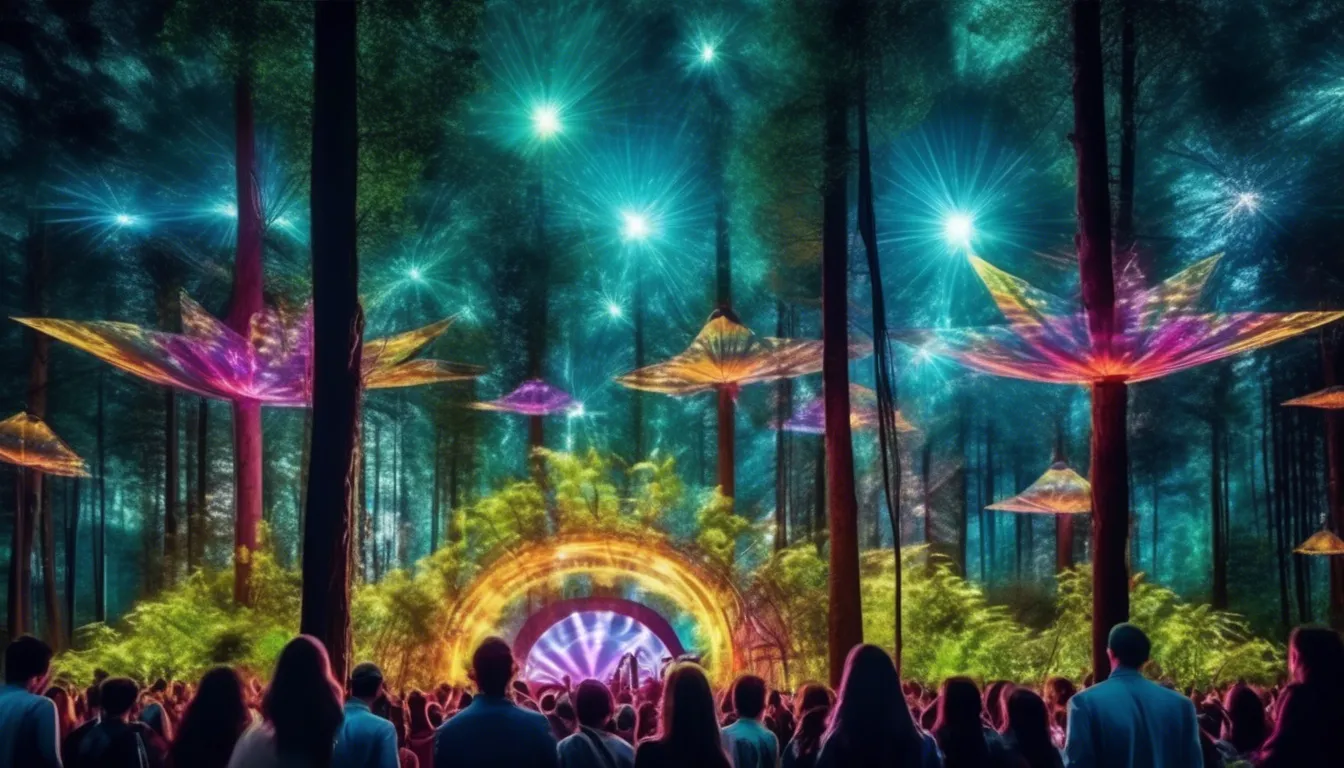Dazzling Highlights Electric Forests Festival Entertainment
Electric Forest festival is known for its eclectic and diverse lineup of entertainment that caters to all tastes and preferences. Fro...
Unlocking the Thrills of Jurassic Park
In Movies, featured, Jun 11, 2024Exploring the Magical World of Pixar Animation Entertainment
In Animation, featured, Jun 11, 2024Unleashing the Magic The Electric Daisy Carnival Experience
In Festival, featured, Jun 11, 2024Unleash your inner warrior in the world of Fortnite
Step into the world of Fortnite and unleash your inner warrior as you battle it out against other players in this popular online game...
Read MoreAll Stories
Dazzling Highlights Electric Forests Festival Entertainment
Electric Forest festival is known for its eclectic and diverse lineup of entertainment that caters to all tastes and preferences. From live music performances by top artists in variou...
In Festival, featured, Jun 11, 2024Unlocking the Thrills of Jurassic Park
“Jurassic Park” is a timeless classic that continues to captivate audiences with its thrilling storyline and groundbreaking special effects. Released in 1993, this Steven Spielberg-di...
In Movies, featured, Jun 11, 2024Exploring the Magical World of Pixar Animation Entertainment
Step into the enchanting and captivating world of Pixar Animation Entertainment, where imagination knows no bounds and creativity thrives. From beloved classics like “Toy Story” and “...
In Animation, featured, Jun 11, 2024Unleashing the Magic The Electric Daisy Carnival Experience
Get ready to immerse yourself in a world of music, art, and magic at the Electric Daisy Carnival (EDC). This annual electronic dance music festival is known for its larger-than-life s...
In Festival, featured, Jun 11, 2024Discover the Excitement of Thrillville A Theme Park Adventure
Step right up and experience the excitement of Thrillville: A Theme Park Adventure! This thrilling video game allows players to design and manage their very own theme park, complete w...
In Theme Park, featured, Jun 11, 2024Coachella Where Music and Entertainment Come Together
Coachella, one of the most anticipated music festivals in the world, is a place where music and entertainment collide to create an unforgettable experience for attendees. Held annuall...
In Music, featured, Jun 11, 2024Dive into Excitement with the Latest PlayStation Games!
Calling all gamers! Get ready to dive into excitement with the latest PlayStation games that are sure to keep you on the edge of your seat. From intense action-packed adventures to th...
In Games, May 14, 2024Unleashing the Magic Electric Forests Mesmerizing Festival Entertainment
Electric Forest is not just a music festival; it’s an immersive experience that transports attendees to a whimsical wonderland filled with captivating entertainment. From spellbinding...
In Festival, May 14, 2024Unveiling Marvel Comics A Universe of Entertainment
Marvel Comics has been dominating the entertainment industry for decades with its diverse array of superheroes and villains. The comic book giant has not only captured the hearts of f...
In Comics, May 14, 2024Embark on an Adventure at Thrill World!
Get ready to embark on the ultimate adventure at Thrill World, the newest and most exhilarating amusement park in town! Whether you’re a thrill-seeker looking for a heart-pounding rol...
In Theme Park, May 14, 2024Featured
-
Dazzling Highlights Electric Forests Festival Entertainment
In Festival, featured, -
Unlocking the Thrills of Jurassic Park
In Movies, featured, -
Exploring the Magical World of Pixar Animation Entertainment
In Animation, featured, -
Unleashing the Magic The Electric Daisy Carnival Experience
In Festival, featured, -
Discover the Excitement of Thrillville A Theme Park Adventure
In Theme Park, featured, -
Coachella Where Music and Entertainment Come Together
In Music, featured, -
Experience the Ultimate Thrills at Thrillville Theme Park
In Theme Park, featured, -
Exploring the Vibrant Festival Entertainment at Electric Forest
In Festival, featured, -
The Legendary Rockers Rolling Stones Impact on Music Entertainment
In Music, featured,
Here are some interesting websites for you to explore:
. . ........... . ........... ........... . . ........... . .balihealing.org
freshfrances.com
jailbreakpangu.com
ahoyamigo.com
crystalhubermakeup.com
pattonsrv.com
sfpx.org
biyoukyujin.com
rubyandroo.com
skunkdotsbikernews.com
randybayne.com
ycentre.org
sistersoliveandnutco.com
thewomansclubsa.org
govanuatu.com
greenwinebottles.com
gmbnorthwest.com
basedigitalphotography.com
coloradohomesiq.com
specialneedsalmanac.com
gusduffyarchitect.com
sandracasado.com
mdoga.org
mayabeaudry.com
meizhouphuket.com
lokswasthya.org
sandrahansondesign.com
changagoidem.org
detroitchampsauto.net
maorimoaketonu.org
arringtonmusic.com
chicagochristmascrawl.com
cataimagem.com
medalyedesigns.com
thomastonford.com
emilycasey.com
haircutmenwaterburyfallsofallonmo.com
melronplumbing.com
aeroinfoinc.com
nicholashutcheson.com
lynnemariemartens.com
yasutoshiezumi.com
malayabiosciences.com
internacionaldeequipos.com
complejopalco.com
pueblojuneteenth.org
lauraemasonfoundation.org
ativaraftingvaleeuropeu.com
drrupalshahlasik.com
billstotalcomfort.com
magicessays.net
hmtt.net
focusinternationalinc.org
rozhermant.com
todoenamorados.com
corpolineal.com
vergersaintpatrice.com
cyprussummerschool.com
haircutmengrandforksnd.com
sterlingengraved.com
patrickmoriarty.org
fastfatlossonline.com
talentgrids.com
diseaseszoom.com
tehamatrail.com
asppo.org
mandenomoments.com
essayscribes.com
drivesmartwesttexas.org
speakoncruises.com
socksmovement.org
kisasgiftsandtrinkets.com
oopsmobile.net
joeortho.net
lacorua.com
yourensemble.com
charismabeautysalon.net
kortrading.com
kolosovska.com
joegallivan.com
hayatimizegitim.com
cypruscompanieslaw.com
cartagenaherald.com
wattacroc.com
nextuniversitydegree.com
mommyladyclub.com
thevillasonline.com
lotusws.com
kellerscontracting.com
bluegalaxydj.com
alignloveland.com
thectsa.org
freesportingpicks.com
crintermex.com
beavercreekwinery.com
trianglegroup.org
drsanjaisahai.com
delivancouver.com
candpautos.com
bioboxsolutions.com
numatexinc.com
boroniasoccerclub.com
dialogosdelconocimiento.org
panamagringoguide.com
diarioleonense.com
angelsheartdogrescue.com
cheersjess.com
orangewoodchurch.org
psicologiavalencia.net
teambj.com
westshoremx.com
amxander.com
anniethornton.com
gorkemunel.com
magneticlenses.com
cfpup.org
holleymaherblog.com
iyadav.com
janewatkinson.com
littlestangelguild.org
snesorama.com
benditatierrasanadora.com
twoweekstotaxi.com
luckenbillappraisalservice.com
goldenfoxsite.com
albasmacenter.com
altemuscorners.com
planetgenerators.com
santaclaritavirtualjobfair.com
hooksbass.com
sneezesnoozeclinic.com
justinhhayeslaw.com
ahanaenterprises.com
daweaverddsms.com
ellisensemble.com
comoemagrecerlogo.com
midpas.com
elfaroensenada.com
espefrut.net
miltrodriguez.com
epcommsconsulting.com
moorsidehigh.net
decorativepaintingbillingsmt.com
promosenterprise.com
rollingsautomotiveinc.com
lindseyowencustomjewelry.com
lentischibeach.com
juliecochran.com
coloruxstudios.com
hopeandhealingsos.com
heathergibsonmassage.com
businessnetwalking.com
digzol.com
gsodirect.com
clientworksarea.com
webautomotivesrl.com
swansonandmyers.com
kkawakami.com
worldguidedtours.com
atlantisdating.com
starshinesolutions.com
zoodleslicer.com
whitnashplumbing.com
juliamafalda.com
estudiomaqui.com
fightlikeacanadian.com
goldshieldsport.com
jeddahpro.com
linamarquez.com
forspecialoffer.com
soulthirstpodcast.com
aolautomate.com
shanebarr.com
identificacaopatrimonial.com
whittiershome.com
beemyteacher.com
punchthesphinx.com
lorilbravo.com
toserda.com
csghosthunters.com
vietanalytics.com
myutahappraisers.com
chccb.com
dearanapaula.com
rafflescorporate.com
bunhafaun.net
barrygilbertcpa.com
emprendeahora.org
clubedasmotocas.com
theatrenashville.com
declanplummer.net
rcdronenews.com
yondermagnetik.com
hannityisamoron.com
thehydroshops.com
ihalematik.com
leroyward.com
computethai.com
ebray.net
knightandknights.com
dixiewasteservices.com
springfieldcrimestoppers.com
ksaforsaudi.com
haruhikosien.com
clarkssteakhouse.com
goldenfoxsite.com
poshdealz.com
rambleontheisland.com
digdeepplayhard.com
safetynetspokane.org
letiga.com
zacharycashion.com
uberzom.com
purelifeenergysaunas.com
rheaofhope.org
kryptikrose.com
miningphoto.com
dscosmetic.net
hotkicksusa.com
licajaygupta.com
binkandboo.net
austinfan.com
fehrenbachs.com
adampenderphotography.com
xesiontube.net
chitaweefrenchies.com
bbcdora.com
ttcingarretson.com
adjohnsonfirm.com
trianglevisionscary.com
bewellusf.com
journeywithrobertthurman.com
barreledcharlotte.com
oglalacommemoration.com
foxbrotherspainting.com
heavyhandedradio.com
agapanthusrising.com
atpancakehousegrill.com
ekalavvya.com
ahsapcncislemeankara.com
lecicalebb.com
attvideoshare.com
devmagazine.org
gobimongoliangrilldenton.com
theseniorcitizenslawcenterplc.com
gregvojtko.com
sofakingdrunk.com
eaglelodgecolorado.com
santaclaritavirtualjobfair.com
hooksbass.com
sneezesnoozeclinic.com
davidsloan.org
justinhhayeslaw.com
ahanaenterprises.com
daweaverddsms.com
ellisensemble.com
comoemagrecerlogo.com
midpas.com
elfaroensenada.com
espefrut.net
miltrodriguez.com
epcommsconsulting.com
moorsidehigh.net
decorativepaintingbillingsmt.com
promosenterprise.com
siddhimetal.com
rollingsautomotiveinc.com
lindseyowencustomjewelry.com
lentischibeach.com
juliecochran.com
coloruxstudios.com
hopeandhealingsos.com
heathergibsonmassage.com
businessnetwalking.com
digzol.com
gsodirect.com
clientworksarea.com
webautomotivesrl.com
swansonandmyers.com
kkawakami.com
tinyshinystuff.com
ryanscreativeuniverse.com
effecortamilano.com
sandiegoliquordepot.com
turkishfruits.org
labellablog.com
albasmacenter.com
astrologizing.net
heritageensemble.com
homesforsalehamilton.com
freemindmedia.org
popchurchcovina.com
altemuscorners.com
theblogofleire.com
cakedesignersworldchampionship.com
duncansvillelutheran.com
fumcconover.org
awcus.org
oopspregnant.com
englishsanguosha.com
planetgenerators.com
retrodollsus.com
squawkboxsound.com
catskillregionguide.com
freedomtoteach.org
shcatthecourtyard.com
dostlukspor.com
abbaziadisantandrea.com
tuskast.com
hadadanziki.com
janswerks.com
rodolfopeluso.com
seanwalkerphotography.com
thatsmilan.com
flamingobeachcyprus.com
pkaassociates.com
copdandsomuchmore.com
violinsviolascellosbass.com
superbgsite.com
cpclakewood.com
pearlandtexasrealestateblog.com
mechanicalrobotfish.com
mrandmrslemon.com
mohometours.com
perlesdartemis.com
langiulli.com
centrevillematane.com
mtnyemen.com
jcstennis.com
randomactsofdance.com
ryzart.com
yankeeselfstorage.com
sashcf.com
onnrainnmcm.com
nailfunguscentral.com
bigdaybuses.com
allaboutuhair.com
allcityelectricmotorrepair.com
anhonestmom.com
bbiverson.com
gthicks.com
hanovermilitary.com
marcusreedlaw.com
tagsignature.com
thedentmaninc.com
vickishomecarellc.com
thefamilyinsurancecenter.com
tabrej.com
salmescup.com
quintadocovanco.com
harvestclay.com
yasminpuncak.com
tcprimarycare.com
socialbuzztv.com
northernrainbows.com
nishijinkongs.com
matodoshomens.com
lookingforarrangement.com
lifestyleadventuresasia.com
joycephoenixlaw.com
heartsandstarssalon.com
genoatangomarathon.com
framingpalace.com
dyberryweaver.com
ccmgaragedoors.com
bravoallstarz.com
wasabiwok.com
topcartomanziatelefonica.com
sevenyearsinadvertising.com
ricebowlchineserestaurant.com
procourseceus.com
kizombanation.com
iefluids.com
glysci.com
georgeinaki.com
allocstore.com
silverpursuit.com
myweddinginloscabos.com
certifiedautosalesaz.com
burneyfallstrailerresort.com
armeriasasso.com
frentrep.com
fiestaresortcc.com
hrwtechsupport.com
domainedesprevelieres.com
nerdoutloudpod.com
cdvedruna.com
healyourgrid.com
oshobrasil.com
thesidecarlounge.com
literaryphotographer.com
hoplouie.com
biburyholidaycottages.com
mechamperformance.com
jmpientka.com
bamthestore.com
captainvisger.com
blueflowersoycandles.com
salmonfallsriverrvresort.com
dalereagan.com
uniqueshoppes.com
activejeremy.com
vermeeragequipment.com
wstable.com
cascadelashstudio.com
roseoftheparty.com
brettblog.com
getbrushed.com
tattoodirector.com
sofiasanchezb.com
pixsharp.com
amygvw.com
puredailybliss.com
beyunique.com
thelearningadvantage.com
clicdocet.com
moritatsurigu.com
hometownemporiumexeter.com
valentinedentistry.com
comeichi.com
konkanmail.com
alegriabazaar.com
bonnymeedfarm.com
angryclownent.com
savannahhorrocks.com
uswaycorp.com
thisolthingvintage.com
noroghi.com
beyunique.com
coolestbrushes.com
getbrushed.com
pixsharp.com
scarboromusic.com
aurigalogic.com
cakegrrl.com
cyclemarche.com
dannyomahony.com
gpscrew.com
hiddentreasuresdecorandmore.com
hoanm.com
ktyoho.com
luvaboos.com
moritatsurigu.com
newcastservices.com
realhornby.com
threesistersforge.com
kesharicarpets.com
greenfutureconstruction.com
draragon.com
shawlandsarcade.com
torontosalsapractice.com
robertopolisano.com
tykesontrikes.com
austinwarnock.com
iannonechem.com
nicolthomas.com
penningtondance.com
timwoodroof.com
agriturismoleduetorri.com
cartistick.com
chesapeakemarinerailway.com
fishmongerart.com
grapplingcontests.com
horsegoeswest.com
hotellepiedmoutet.com
katymusiclessons.com
medievalphotography.com
superiorsitesafety.com
trailsendguesthouse.com
upmmas.com
vezirkopruozlem.com
forodegeneticabovina.com
hrajcar.com
lowguys.com
lymankitchens.com
pearlfishers.com
pedrograncha.com
priotgroup.com
signners.com
ridanpublishing.com
stepstoatrademark.com
thebrownstoneworkshop.com
cenasdelmundo.com
atriumzenonhotelapts.com
alliedconcreteusa.com
hitacllc.com
theallergybible.com
ulianahairstudio.com
vibzuptown.com
dorihome.com
jiyukojo.com
lilpiddlers.com
wisemanboxers.com
pensamientosindiscretos.com
fluffpeachybeandesigns.com
photomunn.com
thevintagehandbag.com
puntotendafigline.com
padegs.com
gailarlidge.com
mpencanete.com
latimes.my.id
super-gadget.my.id
nexpart.my.id
gizmodo.my.id
frieze.my.id
eloquii.my.id
seriouseats.my.id
supercheapauto.my.id
cars24.my.id
digitaltrends.my.id
gymshark.my.id
alternet.my.id
semualaporan.my.id
hedlundpainting.my.id
inman.my.id
tirerack.my.id
weightwatchers.my.id
netdoctor.my.id
loungeunderwear.my.id
getboober.my.id
artspace.my.id
mayoclinic.my.id
sallysbakingaddiction.my.id
gasbuddy.my.id
plated.my.id
freetravel.my.id
careerstrategic.my.id
sagetravel.my.id
financeapp.my.id
healthyshack.my.id
wavetravel.my.id
seekfinance.my.id
travelgear.my.id
irresistiblepets.my.id
dwell.my.id
breitbart.my.id
aforkandapencil.my.id
heavenlynnhealthy.my.id
sethlui.my.id










